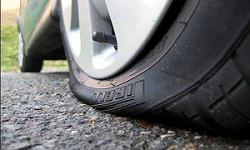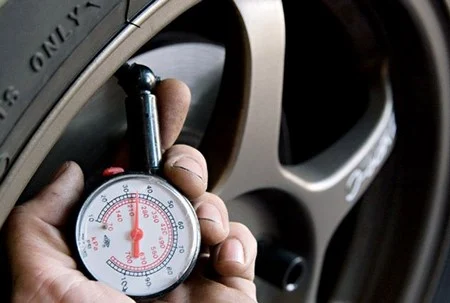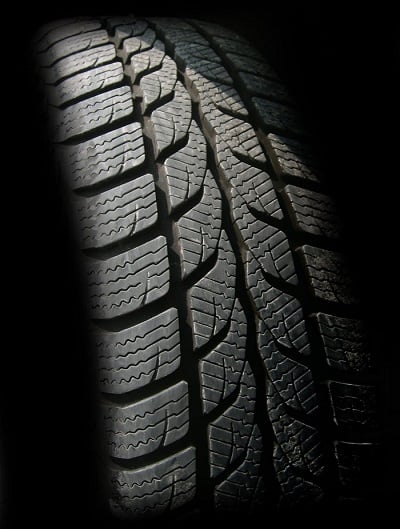Why do tires burst?
Tire blowouts are caused by several factors including lack of proper tire inflation, overloading, excessively worn tread or damaged tread due to neglect and warmer temperature. The National Highway Traffic Safety Administration (NHTSA) estimated that 19,000 people are injured due to tire-related motor vehicle crashes in 2015, and 733 die due to tire malfunctions in vehicle accidents in 2016.
What to do if your tires blow out?
- Avoid slamming on the brakes as this could result in loss of traction;
- Counter-steer the pull and keep you in a straight line
- Let your car slow down gradually
- Steer your car off the road and change the tire or to call for roadside assistance
Reasons Why Your Tires Blow Out: What You Need To Know

Experiencing a tire blow-out is probably one of the basic concerns that new drivers worry about. Data shows that tire blowouts occur in 6.5 percent of cars that comprise more than 80 percent the vehicles involved in the crashes in France from 1996 to 2002. Tire blow-outs were also more prominent in vans at 22 percent. The rate decreased from 8.0 percent in 1997 to 5.9 percent in 2002.
The National Highway Traffic Safety Administration (NHTSA) reported an annual estimate of 414 deaths, 10,275 injuries, and 78,392 crashes due to flat tires or tire blowouts in 2003. These figures were recorded before the NHTSA established two Federal Motor Vehicle Safety Standards that require tire pressure monitoring system (TPMS) on all new light vehicles (Federal Motor Vehicle Safety Standards (FMVSS) No. 1382); and the updating of the performance requirements of all passenger car and light-truck radial tires (FMVSS No. 1393).
The TPMS was designed to help monitor air pressure of various tire types and was seen to aid in reducing fuel consumption and carbon dioxide emissions and to avoid traffic accidents. But despite the safety protocols in place, the number of accidents related to tires blowout is still alarming. The NHTSA’s data showed that an estimated 19,000 people were injured due to tire-related motor vehicle crashes in 2015, and 733 total deaths due to tire malfunctions during motor vehicle accidents in 2016.
Why do car tires blow out? How should you avoid a tire blow-out?
What causes tires to explode
There are several reasons that cause car tires blowout and these are brought by different factors, including vehicular, driver, and environmental. The most common answers that you can find when you ask why do tires blow out include under-inflation, overloading, tire wear, damaged tire, aging tire, and manufacturing defects. These are mostly effects of a vehicular-related factor.
A study published by the NHTSA in April 2012 looked at tire-related factors in the pre-crash phase of motor vehicles. The study found out that a tire’s crash role could either be active or inactive. If at least one of the tire-related crash factor is present during the pre-crash phase, then the tire plays an active role in the crash.
However, if none of the factors is present in the pre-crash phase then the tire plays an inactive role in the crash. What are the variables tire-related crash factors?
- Tire or wheel deficiency like a blowout or air out
- Blow out or flat tires that caused loss of vehicle control
- Tires or wheels failed or tire has already degraded
Vehicular factor
The vehicular factor in car crashes include the status of the tire pressure (inflation), depth of tread, damage to tire prior to crash like tread separation, the use of TPMS, vehicle body type, and whether the vehicle rolled over or not.
Why do tires blowout because of under-inflation? under-inflation not only decreases fuel economy. It can lead to separation or tire blowout due to the following effects on cars and tires:
- Poor vehicle handling
- Longer stopping distances
- Increased stress to other tire components
- Heat buildup
According to the study, cars that have more than 25 percent under-inflation of the recommended pressure composed the estimated 10 percent of vehicles that experience tire problems in the pre-crash period. Tires that are correctly inflated, on the other hand, have a much smaller percentage of involvement in tire problems.
However, the study noted that under-inflation is not the only reason for tire problems, but it increases the chance of tires to play part in the critical event of pre-crash phase by three times.
Meanwhile, tires with tread depths of 2/32” or less, increase the chances of tire problems on vehicles by three times more than those with a tread depth of between 3 to 4/32”. Usually, new car tires have a tread depth of 10/32” to 11/32”.
Vehicles that were rolled over also have a higher rate of experiencing tire problems. Based on the study, 45 percent of SUVs that experienced tire problems were rolled over.
Driver factor
Aside from vehicular factors, driver and environmental factors contribute to car crashes. Inexperienced driver with no or lacks knowledge in driving will find it hard to maneuver vehicles during difficult situations. When tire blowouts happen, experienced drivers may be able to maneuver with ease compared to inexperienced drivers. Aggressive drivers who overspeed, accelerate rapidly from a stop and stop suddenly also makes the vehicle prone to more risks and accidents. Tire blowouts happen too when cars are driven at a high speed.
Environmental factor
Meanwhile, data shows that many vehicles experience tire problems when driven on wet roads, roads underwater or slick surface. That’s how the season plays a significant role in tires’ performance.
Tire companies usually track the so-called “tire-blowout season” from the middle of May until early October. You might ask: Why do tires blow out more in the summer? What is it with the summer season? It’s the hottest time of the year and it’s when people are driving farther, longer, faster, and yes, probably more loaded because of summer vacation.
If you have an under-inflated tire running on a road loaded than usual on a summer, then the heat buildup due inside the tires’ exteriors are more heightened. Those factors combined could lead to a blow-out and worse, a crash.
What do you do if your tire blows out?
After the booming or banging sound of a tire that has exploded, drivers should avoid slamming on the brakes. Slamming the brakes could result to the loss of traction on tires making you unable to control your car. Depending on which tire exploded, the car will tend to pull strongly to either left or right. However, moving cars, despite a tire-burst, can still be steered. Counter-steer the pulling to keep you in a straight line and let the car slow down gradually. You must try to steer straight ahead to stop and pull the vehicle off the road.
Once you are off the road, turn on your emergency flashers and put out reflective cones or triangles as a sign for other drivers. You may change the tire with the temporary spare tires or call for roadside assistance.
How do you avoid a tire blow-out?
Vehicle maintenance is key to preventing tire blowouts and accidents. Here are some tips to avoid tire explosions:
1.Check your tire pressure regularly. Monthly tire pressure check will help keep your tires maintain the recommended inflation. If your car does not have a TPMS, check the pressure with a gauge and inflate the car tires when it’s cold. Keeping the tire pressure in check reduces accidents. Tire pressure is related to almost 20 percent of accidents involving heavy-duty vehicles, a research shows. It was also found out that accidents involving death or serious injuries caused by a truck or tractor driver range from 7.5 percent to 10 percent. But researchers say that maintaining air pressure in tires can help reduce the number of tire-related accidents between 4 percent and 20 percent and decrease the total number of accidents by 0.8 percent to 4 percent.

Look for punctures that might cause leaks and blowouts. You may find soapy water useful in detecting small punctures as bubbles will form on holes. Like under-inflation, overinflation is also dangerous to tires. Overinflation can lead to loss of traction especially during the winter. It also creates a rougher ride.
Here are some tips on how to maintain proper tire inflation:
- If you are frequently on the road, you should check your tires more often. Sports and used performance tires also need more frequent checks as they have thinner sidewalls compared to off-road tires.
- Check the air pressure when the tires weren’t used in the past two hours, at the minimum or during when they are cold. When checking tires after a little more than 15 minutes of driving, take out 1-2 PSI from your air pressure reading.
- Calibrate your pressure gauge to get the most accurate reading. Poorly-calibrated gauge won’t help you monitor how your car tires are losing air.
- Passenger vehicles usually require a tire pressure between 30 to 50 psi, while off-road may require about 80 to 100 psi. Remember that a tire on a light car at about 23 to 39 psi and 60 to 75 psi for heavy motor vehicles may be dangerous when you apply the 25 percent pressure decrease rule.
2.Keep the tire load and speed ratings matched. Look at your car’s manual for the recommended load index and speed ratings.
Overloading your vehicle is dangerous to the tire. Read on your load capacity on the sidewall of your tire.
| Load Index | Pounds | Kilograms | Load Index | Pounds | Kilograms | Load Index | Pounds | Kilograms | ||
| 70 | 739 | 335 | 89 | 1279 | 580 | 108 | 2205 | 1000 | ||
| 71 | 761 | 345 | 90 | 1323 | 600 | 109 | 2271 | 1030 | ||
| 72 | 783 | 355 | 91 | 1356 | 615 | 110 | 2337 | 1060 | ||
| 73 | 805 | 365 | 92 | 1389 | 630 | 111 | 2403 | 1090 | ||
| 74 | 827 | 375 | 93 | 1433 | 650 | 112 | 2469 | 1120 | ||
| 75 | 853 | 387 | 94 | 1477 | 670 | 113 | 2535 | 1150 | ||
| 76 | 882 | 400 | 95 | 1521 | 690 | 114 | 2601 | 1180 | ||
| 77 | 908 | 412 | 96 | 1565 | 710 | 115 | 2679 | 1215 | ||
| 78 | 937 | 425 | 97 | 1609 | 730 | 116 | 2756 | 1250 | ||
| 79 | 963 | 437 | 98 | 1653 | 750 | 117 | 2833 | 1285 | ||
| 80 | 992 | 450 | 99 | 1709 | 775 | 118 | 2910 | 1320 | ||
| 81 | 1019 | 462 | 100 | 1764 | 800 | 119 | 2998 | 1360 | ||
| 82 | 1047 | 475 | 101 | 1819 | 825 | 120 | 3086 | 1400 | ||
| 83 | 1074 | 487 | 102 | 1874 | 850 | 121 | 3197 | 1450 | ||
| 84 | 1102 | 500 | 103 | 1929 | 875 | 122 | 3307 | 1500 | ||
| 85 | 1135 | 515 | 104 | 1984 | 900 | 123 | 3417 | 1550 | ||
| 86 | 1168 | 530 | 105 | 2039 | 925 | 124 | 3527 | 1600 | ||
| 87 | 1201 | 545 | 106 | 2094 | 950 | 125 | 3638 | 1650 | ||
| 88 | 1235 | 560 | 107 | 2149 | 975 | 126 | 3748 | 1700 |
3.Avoid potholes and road hazards. Damages to the tire due to potholes on rough roads may cause a tire sidewall blowout. Where there are potholes, slow down your vehicle and don’t apply the brakes directly to the potholes.
4.Take your tires to technicians. Professionals may notice those developing uneven wear or small punctures better than you can. Take time to have a technician inspect your tires. The tires may also need to be balanced, rotated or repaired for safety.
If you don’t have time for the regular check up with car technician, you may inspect your tires for the following:
- Visible cracks or cuts on the sidewall
- Uneven tread wear caused by improper inflation, wheels misalignment, damaged tires or problematic suspension parts
- Worn tread
- Bulge or blisters on the sidewall
- Too much vibration or rattling

5.Use good tires on the front and the rear. The frequency of blowouts on the rear tires is also higher. Car owners usually place the best tires in front as they tend to be worn out more quickly.
Here are some of the risks of having a bad tread wear:
- Loss of hydroplaning resistance. When you are driving on wet road surfaces, hydroplaning happens due to loss of traction. The purpose of the ribs and grooves on your car’s tires is to allow you to maneuver effectively. Worn-out treads reduce the driver’s ability to steer. Underinflated tires and car speed can also cause hydroplaning. Look out if your tread depth is only around 4 to 5/32”.
- Loss of grip. Winter tires with 6/32” tread depths or lesser may lose their performance as sipes, which allow tires to get a grip on the road during winter, become shallower.
- Excessive heating. Lower tread depth also increases heating on tires since there is lesser space for air flow between the grooves. Lesser airflow leads to increased heat during the friction.
-
Vulnerable to damage. Worn out tires are easier to get damaged by sharp debris that can lead to excessive air loss, under-inflation, and a tire blow out eventually.
